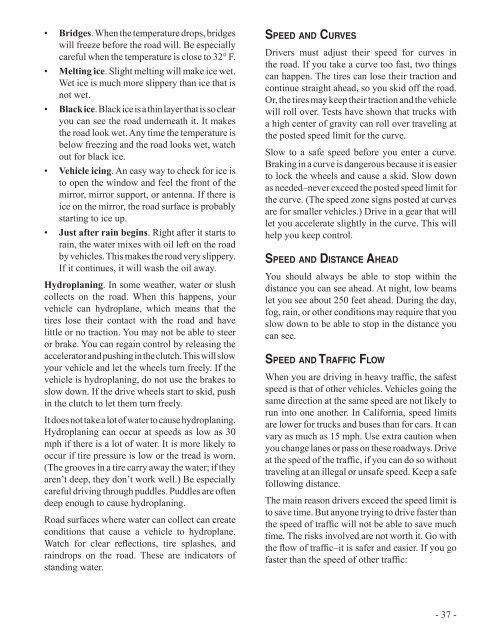Commercial Driver Handbook ( PDF ) - California Department of ...
Commercial Driver Handbook ( PDF ) - California Department of ...
Commercial Driver Handbook ( PDF ) - California Department of ...
You also want an ePaper? Increase the reach of your titles
YUMPU automatically turns print PDFs into web optimized ePapers that Google loves.
• Bridges. When the temperature drops, bridges<br />
will freeze before the road will. Be especially<br />
careful when the temperature is close to 32° F.<br />
• Melting ice. Slight melting will make ice wet.<br />
Wet ice is much more slippery than ice that is<br />
not wet.<br />
• Black ice. Black ice is a thin layer that is so clear<br />
you can see the road underneath it. It makes<br />
the road look wet. Any time the temperature is<br />
below freezing and the road looks wet, watch<br />
out for black ice.<br />
• Vehicle icing. An easy way to check for ice is<br />
to open the window and feel the front <strong>of</strong> the<br />
mirror, mirror support, or antenna. If there is<br />
ice on the mirror, the road surface is probably<br />
starting to ice up.<br />
• Just after rain begins. Right after it starts to<br />
rain, the water mixes with oil left on the road<br />
by vehicles. This makes the road very slippery.<br />
If it continues, it will wash the oil away.<br />
Hydroplaning. In some weather, water or slush<br />
collects on the road. When this happens, your<br />
vehicle can hydroplane, which means that the<br />
tires lose their contact with the road and have<br />
little or no traction. You may not be able to steer<br />
or brake. You can regain control by releasing the<br />
accelerator and pushing in the clutch. This will slow<br />
your vehicle and let the wheels turn freely. If the<br />
vehicle is hydroplaning, do not use the brakes to<br />
slow down. If the drive wheels start to skid, push<br />
in the clutch to let them turn freely.<br />
It does not take a lot <strong>of</strong> water to cause hydroplaning.<br />
Hydroplaning can occur at speeds as low as 30<br />
mph if there is a lot <strong>of</strong> water. It is more likely to<br />
occur if tire pressure is low or the tread is worn.<br />
(The grooves in a tire carry away the water; if they<br />
aren’t deep, they don’t work well.) Be especially<br />
careful driving through puddles. Puddles are <strong>of</strong>ten<br />
deep enough to cause hydroplaning.<br />
Road surfaces where water can collect can create<br />
conditions that cause a vehicle to hydroplane.<br />
Watch for clear reflections, tire splashes, and<br />
raindrops on the road. These are indicators <strong>of</strong><br />
standing water.<br />
speed and Curves<br />
<strong>Driver</strong>s must adjust their speed for curves in<br />
the road. If you take a curve too fast, two things<br />
can happen. The tires can lose their traction and<br />
continue straight ahead, so you skid <strong>of</strong>f the road.<br />
Or, the tires may keep their traction and the vehicle<br />
will roll over. Tests have shown that trucks with<br />
a high center <strong>of</strong> gravity can roll over traveling at<br />
the posted speed limit for the curve.<br />
Slow to a safe speed before you enter a curve.<br />
Braking in a curve is dangerous because it is easier<br />
to lock the wheels and cause a skid. Slow down<br />
as needed–never exceed the posted speed limit for<br />
the curve. (The speed zone signs posted at curves<br />
are for smaller vehicles.) Drive in a gear that will<br />
let you accelerate slightly in the curve. This will<br />
help you keep control.<br />
speed and distanCe ahead<br />
You should always be able to stop within the<br />
distance you can see ahead. At night, low beams<br />
let you see about 250 feet ahead. During the day,<br />
fog, rain, or other conditions may require that you<br />
slow down to be able to stop in the distance you<br />
can see.<br />
speed and traffiC floW<br />
When you are driving in heavy traffic, the safest<br />
speed is that <strong>of</strong> other vehicles. Vehicles going the<br />
same direction at the same speed are not likely to<br />
run into one another. In <strong>California</strong>, speed limits<br />
are lower for trucks and buses than for cars. It can<br />
vary as much as 15 mph. Use extra caution when<br />
you change lanes or pass on these roadways. Drive<br />
at the speed <strong>of</strong> the traffic, if you can do so without<br />
traveling at an illegal or unsafe speed. Keep a safe<br />
following distance.<br />
The main reason drivers exceed the speed limit is<br />
to save time. But anyone trying to drive faster than<br />
the speed <strong>of</strong> traffic will not be able to save much<br />
time. The risks involved are not worth it. Go with<br />
the flow <strong>of</strong> traffic–it is safer and easier. If you go<br />
faster than the speed <strong>of</strong> other traffic:<br />
- 37 -

















